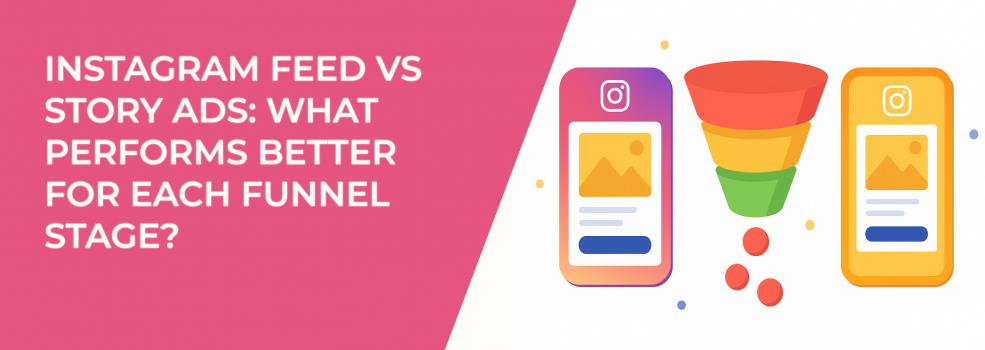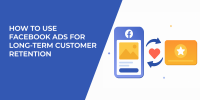Instagram is one of the best platforms for social media advertising. But when planning your Instagram ad campaigns, you need to answer one important question: should you use Instagram Feed ads or Instagram Story ads and when?
The truth is, each placement works differently depending on where your audience is in the funnel. Story ads grab attention quickly. Feed ads give people more time to think. But what works best for awareness, consideration, and conversions?
Let’s walk through each funnel stage and explore which ad type performs better and how you can get better results by using the right format at the right time.
What’s the Difference Between Instagram Feed and Story Ads?
Before we talk strategy, let’s quickly review the key differences between Instagram Feed ads and Story ads. Understanding how users experience each placement will help you choose wisely.
Instagram Feed Ads
These ads appear directly in users’ scrollable feed and give advertisers more space to work with. Here’s what makes Feed ads unique:
-
They appear in the main scrollable feed.
-
You can use longer captions, carousel images, or full-length videos.
-
Ads stay on screen longer — users can pause, read, and engage.
-
They support likes, comments, and shares, offering more interaction.
-
Ideal for in-depth storytelling, brand education, and building trust.
Instagram Story Ads
Story ads show up full-screen in between user-generated Stories. They move fast and create immediate impact. Here’s what sets them apart:
-
They appear in vertical format, full-screen.
-
Each frame lasts only a few seconds.
-
Best used with fast visuals, bold text, and clear CTAs.
-
They disappear after 24 hours, unless saved to Highlights.
-
Perfect for quick impressions, promotions, and time-sensitive campaigns.
Key takeaway: Instagram Story ads are fast and immersive — ideal for attention. Feed ads offer depth and space — better for detail and trust. You need both, but when and how you use them matters.
Before you can create high-performing Instagram ads, you need to be sure you're speaking to the right people — this step-by-step guide to defining your target audience will help you build a solid foundation.
Top of Funnel: Building Awareness
At the top of the marketing funnel, your goal is simple — reach people who don’t know you yet and grab their attention.
Best placement: Instagram Story Ads.
Why do Story ads work so well here? They’re short, mobile-first, and blend into content users are already watching. With the right creative, you can catch a user’s eye in less than three seconds.
To make your Story ads count at the top of the funnel, focus on speed, visuals, and simplicity:
-
Keep it short and visual. Use quick motion, bold headlines, and bright backgrounds to stand out.
-
Focus on one clear message. Don’t overload the viewer — give them one thing to remember.
-
Use vertical video. Make your video feel natural in the format — avoid cropping horizontal clips.
-
Include a CTA. Even at the awareness stage, add a swipe-up link or tap sticker to encourage action.
-
Use sound where possible. Many Story viewers watch with sound on, so include music, voiceovers, or audio cues.
Example: a fashion brand could run a Story ad showing a model spinning in a summer dress, paired with the headline “New Arrivals In!” and a “Shop Now” swipe-up.
Pro tip: don’t stop at one frame. Use a series of 2–3 Story slides to tell a quick narrative. For example: introduce your product, show a benefit, and invite the user to learn more.
If you’re a small business looking to build visibility on Instagram, these Instagram ad strategies will help you run ads that actually spark engagement.
Middle of Funnel: Driving Consideration
Once people know who you are, it’s time to help them consider your offer more seriously. They might have visited your site or engaged with your content. Now they need more detail.
Best placement: Instagram Feed Ads.
Feed ads give you the space and tools to guide a warm audience. You can include more text, link to resources, and share visuals that support your brand promise.
Here, think of your ad as a mini landing page. It should educate, inform, and persuade:
-
Use carousel ads to walk through features, share product benefits, or tell a before-and-after story.
-
Write useful captions that focus on customer pain points and how your product helps.
-
Add social proof by featuring real reviews, testimonials, or “as seen in” mentions.
-
Include behind-the-scenes content or UGC (user-generated content) to build trust.
-
Use clear CTAs like “Learn More,” “See Details,” or “Watch Demo” to drive intent.
Example: a fitness coach could run a carousel Feed ad showing a 3-step workout preview, client before-and-after photos, and a CTA to download a free guide.
Pro tip: create Custom Audiences from people who interacted with your Story ads. Serve those users longer-form Feed ads that go deeper into your product’s value.
Bottom of Funnel: Converting Leads
At this stage, your audience is almost ready to buy. Maybe they’ve visited your site, added something to their cart, or followed your page. You need to push them over the finish line.
Best placement: use Both Feed and Story Ads together.
To maximize conversions, you should combine both ad types — Feed ads for trust, and Story ads for urgency. Each plays a different but essential role.
For Feed ads:
-
Show product reviews or customer testimonials. Social proof builds trust.
-
Highlight time-sensitive offers or bundles. Create urgency around your deal.
-
Use strong CTAs like “Buy Now,” “Start Free Trial,” or “Get Offer.”
-
Link to mobile-friendly landing pages. Reduce friction and load times.
For Story ads:
-
Use countdown stickers to create FOMO and urgency.
-
Mention deadlines in the creative — “Ends Tonight!” or “Only 3 Left!”
-
Include promo codes. This adds value and makes users feel rewarded.
-
Focus the message. One slide = one purpose. No distractions.
Example: a skincare brand might run a Feed ad showing a glowing customer review with a before-and-after photo. They could follow that with a Story ad saying, “Today Only — 20% Off Serums,” plus a swipe-up CTA.
Pro tip: use Instagram Shopping features if available. The faster someone can check out, the more likely they are to buy.
Don’t forget to retarget Story viewers who engaged but didn’t convert — here’s how to set up Facebook retargeting so you can close more leads with the right message.
Final Thoughts
Instagram Feed ads and Story ads are both powerfu, but they serve different purposes at different funnel stages.
If you want more awareness, start with Stories. If you need to explain or convince, use Feed ads. When it’s time to close the deal, use both together for maximum impact.
So ask yourself this: where is your customer in the journey and what do they need to see right now?
Get that right, and your Instagram ads won’t just look good — they’ll perform better, too.
If you're ready to take a deeper dive into funnel-based ad strategy, this full Facebook and Instagram funnel guide breaks down how to move audiences from awareness to conversion step by step.

